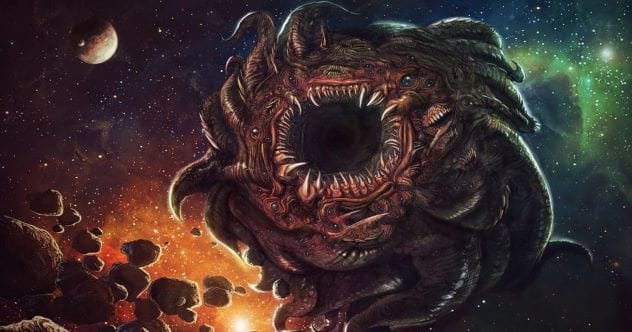H.P. Lovecraft cast a long, tentacled shadow over horror. His tales of cosmic dread and giant, unknowable creatures helped create the Cthulhu Mythos. This type of story often looks at forbidden secrets and how small humans are in a huge, uncaring universe. Even Stephen King has called Lovecraft a master of classic horror. Lovecraft’s ideas didn’t just stay in books. They inspired art like H.R. Giger’s Necronomicon, which helped design the scary aliens in the movie Alien.
Lovecraft’s stories are known as “weird fiction” and “cosmic horror.” They often feature huge monsters with tentacles and explore humanity’s powerlessness. While he’s a horror legend, Lovecraft also held racist views that sometimes appeared in his writing. Luckily, many other authors have taken his ideas, characters, and settings. They have expanded his Mythos with more modern and diverse stories. If you’re looking for a fresh take on cosmic horror, keep reading!
10 The Fisherman (2016), John Langan
John Langan’s The Fisherman tells a chilling Lovecraftian story. It’s about people who take on more than they can handle. We meet Dan and Abe, two men who lost their wives. They bond over their shared love for fishing. They hear stories about a mysterious place called Dutchman’s Creek. It’s said this creek might offer a cure for their sorrow. Even though they’re doubtful, they feel an irresistible pull to visit.
This dark novel blends themes of loss with scary, ancient power. It feels like a mix of Lovecraft’s The Dunwich Horror and Stephen King’s Pet Sematary. The Fisherman begins as a painful look at grief. But as the story unfolds, things get stranger and more terrifying. One reader even said the book caused “anxiety-ridden, sleepless nights.” If you’re a fan of deep and disturbing horror, you’ll want to check this one out.
9 The Dream-Quest of Vellitt Boe (2016), Kij Johnson
Whether you’re a fan of Lovecraft or not, you might enjoy The Dream-Quest of Vellitt Boe by Kij Johnson. Johnson wrote this novella as a response to Lovecraft’s The Dream-Quest of Unknown Kadath. Lovecraft’s story is part of his Dream Cycle, which is more fantastical than his usual horror. It focuses on a magical world that only male dreamers can visit. Johnson changes this by telling the story of Vellitt Boe, a woman who lives in these Dreamlands.
Johnson’s story is both a tribute to Lovecraft and a critique of his lack of female characters. She has said there’s much in Lovecraft’s work to explore or challenge. Her novella doesn’t just comment on Lovecraft’s views on women; it also beautifully expands the magical world he created. Knowing Lovecraft’s original story can add to the experience, but it’s not essential to enjoy Johnson’s version.
8 Meddling Kids (2017), Edgar Cantero
Edgar Cantero’s novel Meddling Kids began with a fun idea: “Famous Five meets Cthulhu.” He imagined a group of former teen detectives reuniting as adults. They realize one of their childhood mysteries wasn’t as simple as they thought. For American readers, the concept was often described as “Scooby-Doo meets Lovecraft.”
In shows like Scooby-Doo, mysteries usually have ordinary explanations, even if they seem supernatural. Meddling Kids flips this. It dives headfirst into the supernatural evils found in Lovecraft’s tales. If you like the idea of a mystery-solving gang encountering Lovecraft’s forbidden knowledge and strange creatures, this book is for you. It’s a fun and spooky mix!
7 The City We Became (2020), N.K. Jemisin
N.K. Jemisin’s fantasy novel, The City We Became, grew from her earlier short story, The City Born Great. In this book, every major city in the world has a human avatar. These avatars are individuals but also represent everything about their city. When New York City’s main avatar falls into a strange coma, new avatars for each of the five boroughs must team up to fight a common enemy.
This enemy, called the Enemy, sometimes looks like a tentacled monster from a Lovecraft story. But it also takes other forms. Jemisin has said the book is her way of dealing with how much fantasy writing owes to Lovecraft, while also facing his serious flaws. The Enemy isn’t just a Lovecraftian monster; it also stands for Lovecraft himself and the racism in his works.
6 The Innsmouth Legacy series (2014-2018), Ruthanna Emrys
This series by Ruthanna Emrys starts with the novella The Litany of Earth (2014). It’s a modern take on Lovecraft’s The Shadow Over Innsmouth. The story continues in two novels, Winter Tide (2017) and Deep Roots (2018). In this world, Lovecraft’s monsters are real. The U.S. government has put them in internment camps. We see things from the point of view of Aphra, one of these so-called monsters. Aphra and her people are like Lovecraft’s Deep Ones. They look human at first but later change into fish-like creatures.
This new perspective gives Lovecraft’s monsters more depth and humanity, even though they aren’t human. Emrys believes that the scary parts and the appealing parts of Lovecraft are linked. She said that Lovecraft helps her understand what it’s like when people see you as a monster, even as his characters are often forced to see things from an “Other’s” point of view.
5 The Mist (1980), Stephen King
Lovecraft’s influence is clear in many of Stephen King’s stories. However, his novella The Mist directly features terrifying Lovecraftian creatures. The narrator, David Drayton, gets trapped in a supermarket with his young son. A strange, otherworldly mist rolls into town, bringing monsters with it. The characters must survive not only these creatures but also the fear and aggression of other survivors.
Frank Darabont directed a successful movie version in 2007. It mostly followed the novella but had a much darker ending, which King himself loved. He called it “terrific” and “anti-Hollywood.” A TV series based on the story came out ten years later but wasn’t as popular. Many believe the show failed because it removed the Lovecraftian monsters that King and Darabont had shown so effectively.
4 Ring Shout (2020), P. Djèlí Clark
P. Djèlí Clark’s novella Ring Shout is set in Georgia. It follows Maryse Boudreaux, who hunts and kills demonic beings summoned by the Ku Klux Klan. Clark mixes the real history of the Jim Crow South with Lovecraft’s supernatural horror. The story explores how people can become metaphorical monsters, not just the tentacled kind. Clark is also skilled at writing body horror, creating vivid and unsettling images.
Like many authors on this list, Clark deals with both the importance and the problematic aspects of Lovecraft’s work. He says his writing isn’t a tribute to Lovecraft but “more so a jab.” Clark takes the good parts of Lovecraft’s stories, like his strange monsters, and cleverly turns the negative elements around.
3 The Courtyard (2003), Neonomicon (2010), and Providence (2015), Alan Moore
Alan Moore, famous for comic books like Watchmen, has also created comics set in Lovecraft’s universe, with Jacen Burrows as the artist. Moore started playing with Lovecraft’s ideas for a collection of stories. His story, “Yuggoth Cultures,” took inspiration from Lovecraft’s poems. This led to a long-term engagement with Lovecraft’s work throughout his career.
Antony Johnston first turned Moore’s ideas into a comic called The Courtyard in 2003. Moore then wrote Neonomicon (2010-2011) and finished the story with Providence (2015-2017). Moore’s comic series doesn’t just challenge Lovecraft’s ideas; it comments on Lovecraft himself and all his writings. It’s helpful to know Lovecraft’s stories before reading these comics, as they connect deeply with his original works.
2 The Ballad of Black Tom (2016), Victor LaValle
Victor LaValle’s award-winning novella, The Ballad of Black Tom, retells Lovecraft’s story The Horror at Red Hook from the perspective of a Black man. Set in Harlem in 1924, it follows Tommy Tester, a hustler. He gets involved with a wealthy recluse, Robert Suydam, in a plot involving Lovecraft’s Great Old Ones. The story mixes cosmic horror and forbidden knowledge with strong commentary on racism in America. A TV show based on the novella is being made by AMC, with LaValle as a producer.
LaValle believes that since Lovecraft’s influence is already so widespread in pop culture, we should “keep the best of it and identify the worst of it.” This approach helped him create a story that addresses the problems in Lovecraft’s horror while still using the powerful cosmic terror from his tales.
1 Lovecraft Country (2016), Matt Ruff
Published on the same day as The Ballad of Black Tom, Matt Ruff’s Lovecraft Country is a novel made of linked short stories. These stories focus on Black characters. We follow Atticus Turner, his friends, and family. They face a secret society of magic users, monsters from other worlds, and the real-life horrors of racism in Jim Crow-era America.
One reviewer called the book “a kind of exorcism” of Lovecraft’s racism. Another said it celebrates “Black nerdery” and the way readers of color can find wonder in genres that often excluded them. Ruff’s novel directly confronts racism in America. It also portrays its Black characters as heroes in exciting sci-fi adventures. HBO adapted the novel into a TV series in 2020. While many liked it, the show was canceled after one season.
These ten stories show that Lovecraft’s cosmic horror is alive and evolving. Authors today are not just copying his style. They are building on his ideas, questioning them, and adding their own voices. They explore themes of fear, humanity, and the unknown in new and exciting ways. By reading these modern tales, we can experience the thrill of Lovecraftian horror through fresh eyes and diverse perspectives. The universe is vast, and so are the stories it can inspire.
What are your favorite Lovecraftian stories not written by H.P. Lovecraft? Share your thoughts and recommendations in the comments below!










